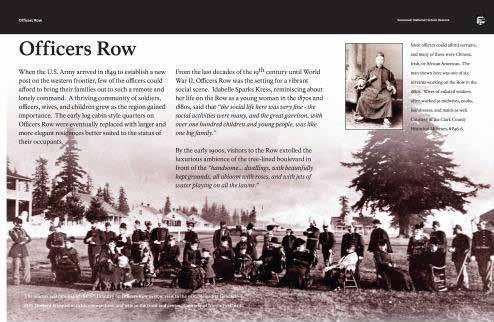
5 minute read
Firsts Monument
5th Street
Firsts Monument
Advertisement
In 1925 members of the Washington State Historical Society commemorated several “firsts” to occur at Fort Vancouver with a monument.
Each panel provides a brief description of an historic “first” from 1825 to
*Under the influence of Dr. John McLaughlin, manager of the Hudson Bay Co. Civilization of Washington started at Vancouver A. D. 1825
The first school in Washington was taught by John Ball at Vancouver A. D. 1833
The first gospel sermon in Washington, was delivered by Jason Lee at Vancouver Sept 28 A. D. 1834
The first marriage of American citizens in Washington was Daniel Lee to Maria T. Ware at Vancouver June 11 A.D. 1840
This memorial erected by the Washington State Society at Vancouver A. D. 1925
* The first panel reflects the bias still very prevalent at the time that Indian culture was not civilized.
E Evergreen Blvd
Text from NPS Interpretative panel at Fort Vancouver NPS
When the U.S. Army arrived in 1849 to establish a new post on the western frontier, few of the officers could afford to bring their families out to such a remote and lonely command. A thriving community of soldiers, officers, wives, and children grew as the region gained importance. The early log cabin style quarters on Officer Row were eventually replaced with larger and more elegant residences better suited to the status of their occupants. here was very fine - social activities were many, and the great garrison, with over one hundred children and young people, was like one big family."
By the early 1900s, visitors to the Row extolled the luxurious ambiance of the tree-line boulevard in front of the "handsome... dwellings, with beautifully kept grounds, all abloom with roses, and with jets of water playing on all the lawns."
From the last decades of the 19th century until World War II, Officers Row was the setting for a vibrant social scene. Idabelle Sparks Kress, reminiscing about her life on the Row as a young woman in the 1870s and 1880s, sad that "the social life
Inset Picture: Most officers could afford servants, and many of these were Chinese, Irish, or African
American. The man shown here was one of six servants working on the
Row in 1880s. Wives of enlisted soldiers often worked as midwives, cooks, laundresses, and maids as well.
51
E Evergreen Blvd
Historical markers placed in front of the houses on Officers Row offer a capsulated history of important events of the U.S. Army’s presence at Fort Vancouver.

ETHNIC DIVERSITY
Ethnic diversity was prevalent in Vancouver. The British had welcomed Scots, English, French Canadians and Hawaiians (Kanakas). American settlers had varied backgrounds including many Germans and Scandinavians. Chinese moved here in the 18-‘s. Indians who refused to move to reservations were imprisoned here. Following the Civil War black soldiers, known as “Buffalo Soldiers”, were sent west to fight Indians. They distinguished themselves by performing bravely, and some settled in Vancouver when they retired. Donated by Jackson Burgess Limited

E Evergreen Blvd

THE ARRIVAL OF THE U. S. MILITARY American soldiers of the U. S. First Field Artillery, Brevet Maj. John S. Hathaway commanding, camped on this hillside overlooking the British Hudson’s Bay Company’s fort. Stripping a fir tree of its branches, the troops raised the U. S. flag over the territory, designating Camp Vancouver, the first military post in Oregon Territory, May 15, 1849. Donated by Clark County Chiropractic Association

WASHINGTON CENTENNNIAL ARBOR DAY In 1879, General O. O. Howard and Col. H. A. Morrow supervised the construction of sidewalks, bridle paths, street lamps and the planting of the first century trees that line the street today. On April 12, 1989, the citizens of Vancouver commemorated the 1879 beautification of Officers’ Row and elementary students planted second century big leaf maples. In memory of Edward C. Bolds. Sr. and Silva Whitfield Bolds
E Evergreen Blvd
THE REHABILITATION
1984 - 1988 On September 4, 1984 the United States deeded Officers Row to the City of Vancouver. The City raised approximately ten million dollars for the rehabilitation of the Row through the sale of bonds, a state grant and city and federal monies. To preserve the buildings the City adapted them for use as offices, townhouses, meeting and exhibition rooms and a restaurant. The initial rehabilitation was completed in October 1988. The buildings continue to be improved through public contributions.
Donated by Greater Vancouver Chamber of Commerce.

THE END OF THE AMERICAN REVOLUTION
The American Revolution began with the “Shot Heard Around the World” in Concord, Massachusetts. The war ended when the United States and Britain agreed on the U.S./Canadian border in 1847 and the U. S. Army constructed Officer’s Row beginning in 1850. This was the first military post in the Oregon Territory.
The command encompassed all of Oregon, Washington, Alaska and much of Idaho. For many years, after the Civil War, it was one of the most prestigious and sought after posts in the country.

E Evergreen Blvd


OLDEST WASHINGTON SETTLEMENT
Federal authorities serving the Northwest after 1850 were guided by the Commanding Officer at Vancouver until after the Civil War.
Vancouver is the oldest settlement in Washington and was the original Washington Territorial capital.
Fort Vancouver was considered by many to be the end of the Oregon Trail.
Donated on behalf of Joseph, Rhonda, Theresa, Denise and Cynthia by their Father Ronald B. Vogel
FIRST U.S. CITIZEN BORN IN VANCOUVER
Near here, on December 20, 1853 in one of the original log cabins of the fort, was born Vancouver’s first child of U.S. parents, Mr. and Mrs. John Eddings, the postmaster.
That cabin was torn down in 1885. The officers at the fort had keenly followed all the events of Napoleon’s career, and voted to name the baby Josephine after the French General’s wife.
Donated by Evergreen Memorial Gardens








